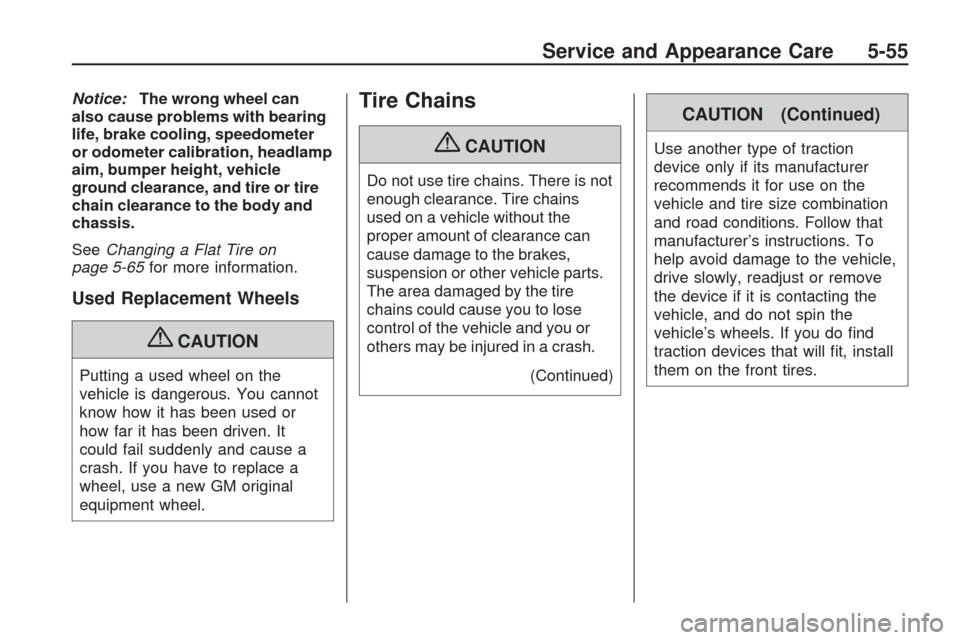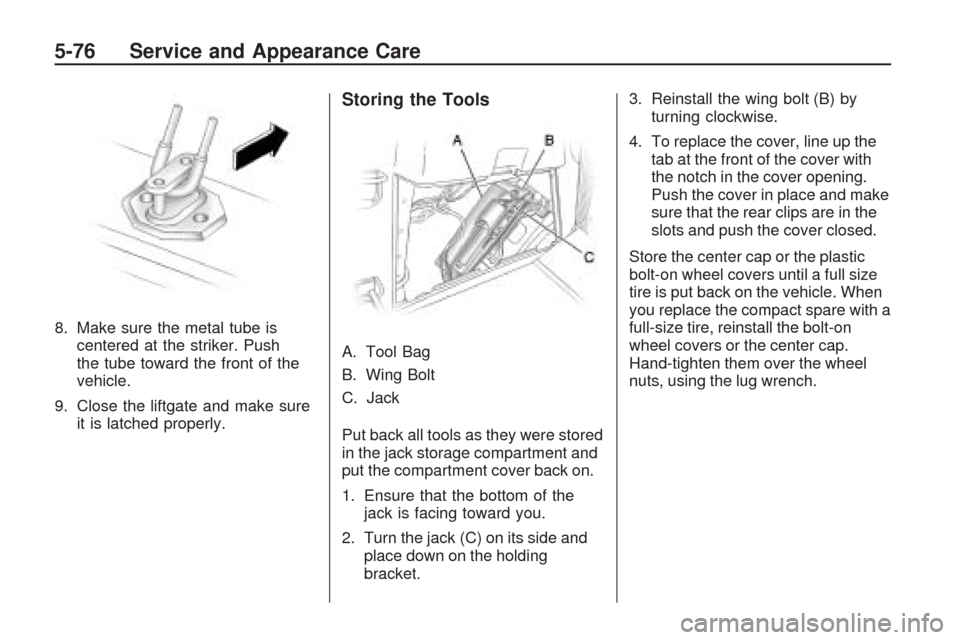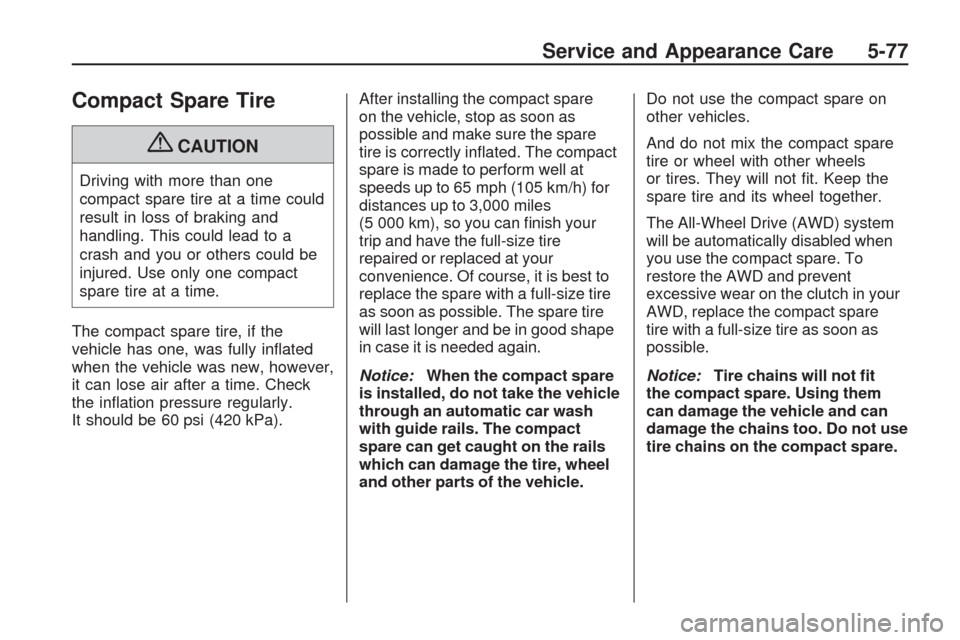Page 337 of 422

Notice:The wrong wheel can
also cause problems with bearing
life, brake cooling, speedometer
or odometer calibration, headlamp
aim, bumper height, vehicle
ground clearance, and tire or tire
chain clearance to the body and
chassis.
SeeChanging a Flat Tire on
page 5-65for more information.
Used Replacement Wheels
{CAUTION
Putting a used wheel on the
vehicle is dangerous. You cannot
know how it has been used or
how far it has been driven. It
could fail suddenly and cause a
crash. If you have to replace a
wheel, use a new GM original
equipment wheel.
Tire Chains
{CAUTION
Do not use tire chains. There is not
enough clearance. Tire chains
used on a vehicle without the
proper amount of clearance can
cause damage to the brakes,
suspension or other vehicle parts.
The area damaged by the tire
chains could cause you to lose
control of the vehicle and you or
others may be injured in a crash.
(Continued)
CAUTION (Continued)
Use another type of traction
device only if its manufacturer
recommends it for use on the
vehicle and tire size combination
and road conditions. Follow that
manufacturer’s instructions. To
help avoid damage to the vehicle,
drive slowly, readjust or remove
the device if it is contacting the
vehicle, and do not spin the
vehicle’s wheels. If you do �nd
traction devices that will �t, install
them on the front tires.
Service and Appearance Care 5-55
Page 349 of 422
1. Open the storage compartment
door of the convenience center
that is nearest the liftgate and
remove the cap on the bottom of
the storage compartment.
2. Open the carpet cutout that is
located through the hole of the
storage compartment.
3. Attach the lug wrench into the
hoist shaft.
4. Turn the lug wrench
counterclockwise to lower
the spare tire to the ground.
Continue turning the wrench
until the spare tire can be pulled
out from under the vehicle.
5. Tilt the retainer and slip it through
the wheel opening to remove the
spare tire from the cable.6. Turn the wrench clockwise to
raise the cable back up after
removing the spare tire.
Do not store a full-size or a �at
road tire under the vehicle.
SeeStoring a Flat or Spare Tire
and Tools on page 5-74.
To continue changing the �at tire,
seeRemoving the Flat Tire and
Installing the Spare Tire on
page 5-68.
If the spare tire will not lower, the
secondary latch could be engaged.
Service and Appearance Care 5-67
Page 358 of 422

8. Make sure the metal tube is
centered at the striker. Push
the tube toward the front of the
vehicle.
9. Close the liftgate and make sure
it is latched properly.
Storing the Tools
A. Tool Bag
B. Wing Bolt
C. Jack
Put back all tools as they were stored
in the jack storage compartment and
put the compartment cover back on.
1. Ensure that the bottom of the
jack is facing toward you.
2. Turn the jack (C) on its side and
place down on the holding
bracket.3. Reinstall the wing bolt (B) by
turning clockwise.
4. To replace the cover, line up the
tab at the front of the cover with
the notch in the cover opening.
Push the cover in place and make
sure that the rear clips are in the
slots and push the cover closed.
Store the center cap or the plastic
bolt-on wheel covers until a full size
tire is put back on the vehicle. When
you replace the compact spare with a
full-size tire, reinstall the bolt-on
wheel covers or the center cap.
Hand-tighten them over the wheel
nuts, using the lug wrench.
5-76 Service and Appearance Care
Page 359 of 422

Compact Spare Tire
{CAUTION
Driving with more than one
compact spare tire at a time could
result in loss of braking and
handling. This could lead to a
crash and you or others could be
injured. Use only one compact
spare tire at a time.
The compact spare tire, if the
vehicle has one, was fully in�ated
when the vehicle was new, however,
it can lose air after a time. Check
the in�ation pressure regularly.
It should be 60 psi (420 kPa).After installing the compact spare
on the vehicle, stop as soon as
possible and make sure the spare
tire is correctly in�ated. The compact
spare is made to perform well at
speeds up to 65 mph (105 km/h) for
distances up to 3,000 miles
(5 000 km), so you can �nish your
trip and have the full-size tire
repaired or replaced at your
convenience. Of course, it is best to
replace the spare with a full-size tire
as soon as possible. The spare tire
will last longer and be in good shape
in case it is needed again.
Notice:When the compact spare
is installed, do not take the vehicle
through an automatic car wash
with guide rails. The compact
spare can get caught on the rails
which can damage the tire, wheel
and other parts of the vehicle.Do not use the compact spare on
other vehicles.
And do not mix the compact spare
tire or wheel with other wheels
or tires. They will not �t. Keep the
spare tire and its wheel together.
The All-Wheel Drive (AWD) system
will be automatically disabled when
you use the compact spare. To
restore the AWD and prevent
excessive wear on the clutch in your
AWD, replace the compact spare
tire with a full-size tire as soon as
possible.
Notice:Tire chains will not �t
the compact spare. Using them
can damage the vehicle and can
damage the chains too. Do not use
tire chains on the compact spare.
Service and Appearance Care 5-77
Page 421 of 422

Tire Sealant and
Compressor Kit................5-64
Tires..................................5-36
Aluminum or
Chrome-Plated Wheels,
Cleaning......................5-83
Buying New Tires.............5-50
Chains............................5-55
Changing a Flat Tire.........5-65
Cleaning..........................5-83
Compact Spare................5-77
Different Size...................5-52
If a Tire Goes Flat............5-56
In�ation - Tire Pressure.....5-42
Inspection and Rotation.....5-48
Installing the Spare Tire.....5-68
Pressure Monitor
Operation.....................5-45
Pressure Monitor System . . . 5-43
Removing the Flat Tire......5-68
Removing the Spare Tire
and Tools.....................5-66
Sealant and
Compressor Kit.............5-57
Secondary Latch System....5-72
Sidewall Labeling..............5-37
Storing a Flat or Spare Tire
and Tools.....................5-74Tires (cont.)
Terminology and
De�nitions....................5-39
Uniform Tire Quality
Grading.......................5-52
Wheel Alignment and
Tire Balance.................5-54
Wheel Replacement..........5-54
When It Is Time for
New Tires....................5-50
Tow/Haul Mode ....................2-26
Tow/Haul Mode Light............3-43
Towing
Recreational Vehicle..........4-21
Towing a Trailer................4-25
Your Vehicle.....................4-21
Traction
StabiliTrak®System............ 4-5
Transmission
Fluid, Automatic................5-16
Transmission Operation,
Automatic........................2-24
Transportation, Courtesy......... 7-9
Turn and Lane-Change
Signals............................. 3-6
Turn Signal/Multifunction
Lever................................ 3-6
U
Ultrasonic Rear Parking
Assist (URPA)..................2-36
Uniform Tire Quality
Grading...........................5-52
Universal Home Remote
System...........................2-47
Operation........................2-47
V
Vehicle
Control............................. 4-3
Loading...........................4-16
Running While Parked.......2-30
Symbols.............................. iii
Vehicle Customization, DIC....3-65
Vehicle Data Recording and
Privacy............................7-16
Vehicle Data Recording,
Radio Frequency (RFID)....7-17
Vehicle Identi�cation
Number (VIN)...................5-85
Service Parts Identi�cation
Label...........................5-85
Vehicle, Remote Start............. 2-6
INDEX i-11
Page 422 of 422

Ventilation Adjustment...........3-27
Visors.................................2-16
Voltage Devices, and Wiring . . . 5-85
Voltmeter Gage....................3-35
W
Warning Lights, Gages, and
Indicators........................3-30
Warnings
DIC Warnings and
Messages....................3-56
Hazard Warning Flashers.... 3-5
Safety and Symbols.............. iii
Wheels
Alignment and
Tire Balance.................5-54
Different Size...................5-52
Replacement....................5-54
When It Is Time for
New Tires........................5-50
Where to Put the
Child Restraint.................1-33
Windows.............................2-14
Power .............................2-14Windshield
Backglass, and Wiper
Blades, Cleaning...........5-82
Washer............................. 3-8
Washer Fluid....................5-24
Wiper Blade
Replacement................5-35
Wiper Fuses....................5-86
Wipers.............................. 3-7
Winter Driving......................4-14
Wipers
Rear Washer..................... 3-9
Wiring, High Voltage
Devices...........................5-85
X
XM Radio Messages...........3-102
Y
Your Vehicle and the
Environment...................... 6-1
i-12 INDEX
Page:
< prev 1-8 9-16 17-24